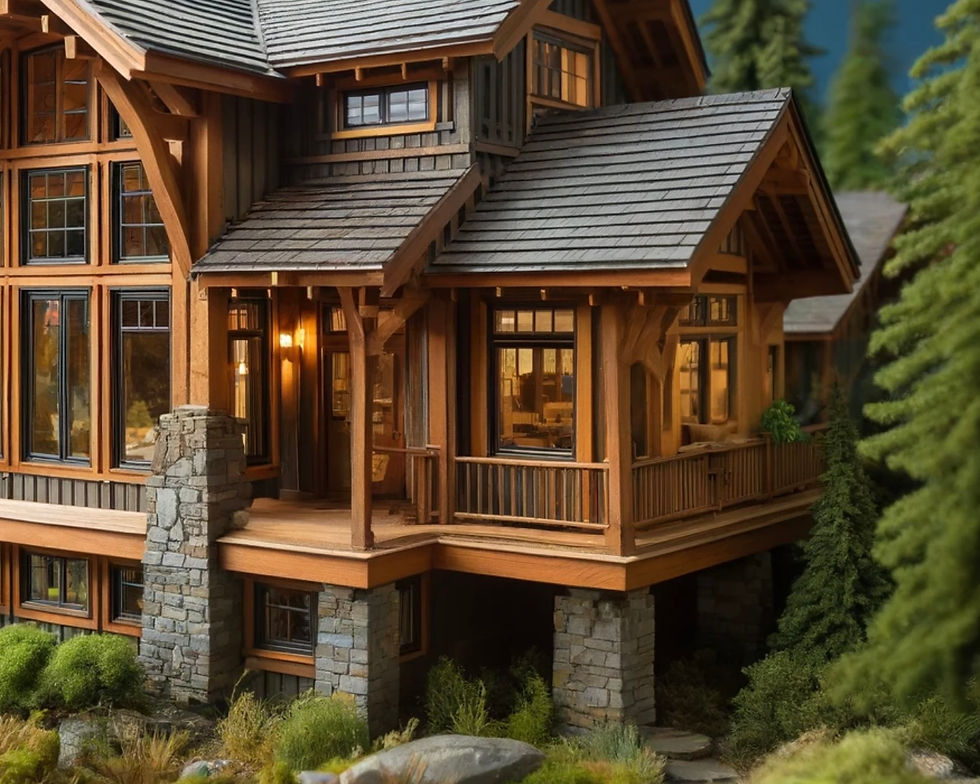Capturing the Essence of Northwest Regional Style in Miniature
- Brandon
- May 29, 2024
- 3 min read

Welcome to Small World Miniatures, where we explore the fascinating art of miniature creations and share stunning examples to inspire your own projects. Today, we delve into a miniature diorama of a home inspired by the Northwest Regional Style. This exquisite model captures the rustic elegance and harmony with nature that define this architectural style.
The Inspiration: Northwest Regional Style
The Northwest Regional Style, also known as Pacific Northwest Style, is characterized by its strong connection to the natural environment. This architectural style emphasizes the use of local materials, large windows to bring the outdoors in, and designs that blend seamlessly with the surrounding landscape.
Historical Significance
Northwest Regional Style emerged in the mid-20th century as architects in the Pacific Northwest sought to create homes that responded to the region’s unique climate and natural beauty. This style is influenced by the principles of organic architecture, pioneered by Frank Lloyd Wright, and incorporates elements of modernism with a focus on simplicity and functionality.

Influential Architects and Artists
Architects such as Pietro Belluschi, John Yeon, and Paul Kirk were instrumental in defining the Northwest Regional Style. Their designs are celebrated for their integration with the natural landscape, use of natural materials, and emphasis on sustainability. These architects provide a rich source of inspiration for miniature enthusiasts looking to recreate the essence of this style.
Design and Elements
Structure and Materials
The diorama features a multi-level home with a steeply pitched roof, large windows, and a strong emphasis on wood and stone. The structure is elevated on stone pillars, adding to its rustic charm and blending seamlessly with the natural surroundings. The use of natural materials like cedar wood and river stone is a hallmark of the Northwest Regional Style.
The model is crafted with meticulous attention to detail, using high-quality materials such as fine wood for the structural elements, detailed resin for the decorative components, and realistic artificial plants to enhance the natural setting. The craftsmanship ensures that each element, from the wooden beams to the stone foundations, is rendered with stunning accuracy.

Colors and Aesthetics
The color palette is a harmonious blend of earthy tones and natural hues. The warm browns of the wood and the cool greys of the stone are complemented by the greens of the surrounding foliage. This cohesive color scheme enhances the overall aesthetic, creating a scene that is both inviting and true to the Northwest Regional Style.
Similar Architectural Examples
For those inspired by this remarkable diorama, several architectural styles and designs share similar characteristics:
• Organic Architecture: Emphasized by Frank Lloyd Wright, this style integrates structures with their natural surroundings, using natural materials and designs that mimic organic forms.
• Mid-Century Modern: Known for its simplicity, functionality, and integration with nature, this style features clean lines, open floor plans, and large windows.
• Rustic Modern: This style combines modern design elements with rustic materials, creating a warm, inviting aesthetic that blends with the natural environment.
Tips for Aspiring Miniature Enthusiasts
Creating a miniature model as detailed and captivating as this Northwest Regional Style home requires dedication, creativity, and a keen eye for detail. Here are some tips to help you achieve similar results in your miniature projects:
1. Invest in High-Quality Materials: Use fine wood, detailed resin, and realistic artificial plants to ensure your model looks authentic and stands the test of time.
2. Plan Your Design Carefully: Sketch your ideas and create a detailed blueprint before starting construction. This will help you visualize the final product and make necessary adjustments.
3. Focus on Intricate Details: Pay close attention to small elements like windows, beams, and landscaping. These details bring your miniature to life.
4. Experiment with Color: Choose a harmonious color palette that reflects the theme of your model. Mixing earthy tones with natural hues can create visual interest and cohesion.
5. Incorporate Natural Elements: Adding realistic plants, stones, and other natural touches can enhance the charm and authenticity of your diorama.
6. Learn from the Masters: Study the work of architects and artists who inspire you. Analyzing their techniques and styles can provide valuable insights for your own creations.
The Northwest Regional Style home diorama featured today is a stunning example of the beauty and creativity that miniature enthusiasts can achieve. By blending the rustic elegance of this architectural style with meticulous craftsmanship and attention to detail, this model captures the imagination and transports viewers to a serene, natural setting. We hope this inspires you to embark on your own miniature adventures and create enchanting scenes that tell your unique story.
#MiniatureDiorama #NorthwestRegionalStyle #OrganicArchitecture #RusticModern #MiniatureArt #ArchitecturalMiniatures #ArtInMiniature #MiniatureInspiration #SmallWorldMiniatures
































Commentaires